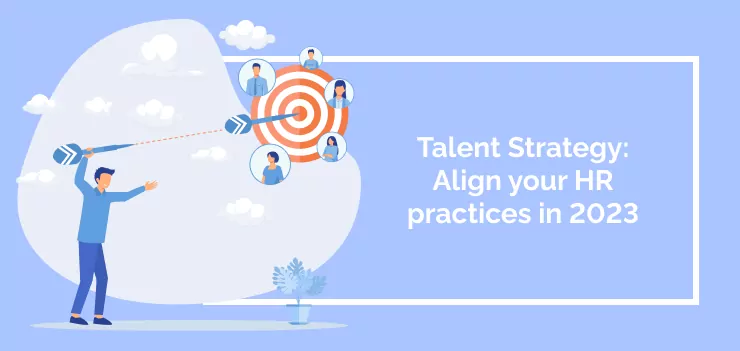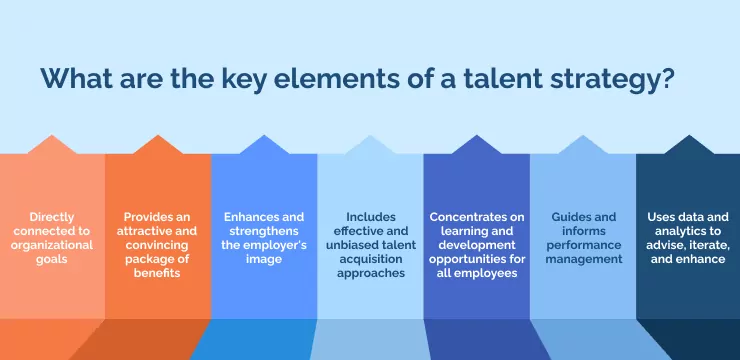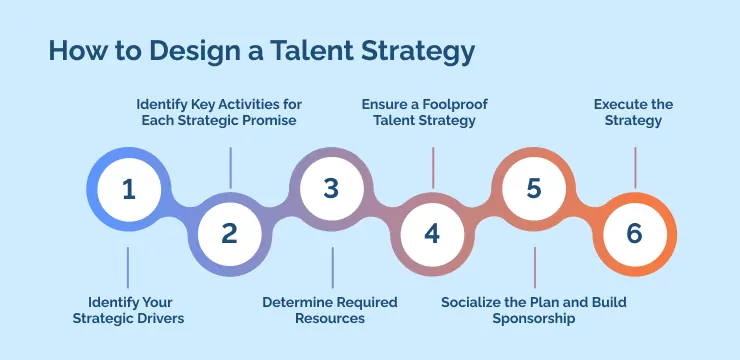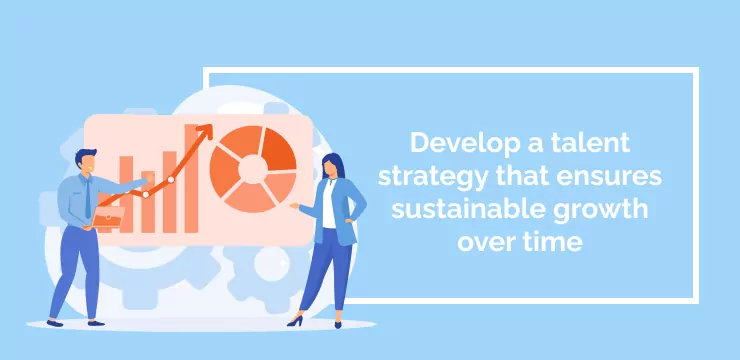
Have you ever wondered why HR teams spend a lot of time and energy trying to align existing HR practices?
Aligning HR practices is essential to successfully implementing any talent strategy. It ensures that all employees have access to the same opportunities for growth and development and that everyone’s performance is measured fairly.
It’s easy to ignore the importance of having a unified talent strategy, but it’s actually one of the most critical aspects to consider when aiming for organizational effectiveness.
According to Gartner’s Digital Age Mandate for HR, 58% of heads of recruiting have difficulty acquiring talent to maintain current business activities. It’s not surprising that, given the above statistics, talent strategy is at the top of the agenda of many organizations.
But what is a talent strategy? Well, it isn’t as complicated as it sounds.
A talent strategy is a comprehensive plan developed by HR professionals to attract, retain, and develop employees in alignment with the organization’s business goals. It includes a range of initiatives and policies to identify and nurture talented individuals who can contribute to the company’s long-term success.
An effective talent strategy involves assessing the organization’s current and future talent needs, creating a positive and inclusive work culture, providing opportunities for professional growth and development, and implementing performance management systems that reward high performers.
It also involves monitoring and adapting to changing workforce management trends and demographics to ensure the company remains competitive in the talent market. HR analytics is another essential component of a successful talent strategy, as it helps HR professionals measure and analyze their initiatives’ impact.
This article will provide you with a comprehensive guide to creating an effective talent strategy for your organization in 2023. We’ll go through the key steps you need to take and provide tips for building an engaging and inclusive talent strategy that will ensure organizational success for many years to come.
What is a talent strategy?
A talent strategy refers to a strategic and organized approach to attracting, developing, and retaining top talent to achieve change management goals.
It includes a plan of action to optimize employee performance, which involves sourcing, hiring, onboarding, engaging, and retaining talent. A successful talent strategy also aims to identify skill gaps early on and to provide employees with the necessary resources and training to help them grow and develop within the company.
Ultimately, a strong talent strategy allows businesses to build a high-performing workforce t drive business results and maintain a competitive edge in their industry.
Why is a talent strategy important?

A talent strategy is crucial for any organization that wants to attract, develop, and retain top talent. An effective talent strategy aligns an organization’s business objectives with its hiring and talent development practices. It also helps organizations identify critical roles and plan for future workforce needs.
One of the key benefits of a talent strategy is that it enables organizations to build a strong employer brand. By creating a positive reputation as an employer of choice, companies can attract high-quality candidates eager to work for them. This can lead to lower recruitment costs and higher retention rates.
Talent strategies emphasize employee development. Organizations that invest in their employees by providing continuous training and growth opportunities can improve employee engagement, job satisfaction, and productivity. This can also help to reduce voluntary employee turnover rates and increase overall organizational performance.
What are the key elements of a talent strategy?

When developing a talent strategy for the first time, you’d do well to remember that there is no one-size-fits-all solution. Every organization has different goals and needs; any strategy should be tailored to meet these demands.
Having said that, there are some key elements of any successful talent strategy.
These include:
- Directly connected to organizational goals: An effective HR strategy should be aligned with the organization’s overall business goals and objectives. This ensures that HR initiatives and programs are designed to support the growth and success of the organization. For example, if an organization aims to increase revenue, the HR strategy might focus on talent acquisition and development in sales and marketing roles.
- Provides an attractive and convincing package of benefits: The employee value proposition is what an organization offers to its employees in exchange for their skills, experience, and commitment. It includes benefits, opportunities for growth and development, work environment, and company culture. A compelling employee value proposition can help attract top talent and retain existing employees.
- Enhances and strengthens the employer’s image: The employer brand is the perception and reputation of an organization as an employer. An effective HR strategy should strengthen the employer brand by creating a positive work environment, providing opportunities for growth and development, and recognizing and rewarding employees’ contributions.
- Includes effective and unbiased talent acquisition approaches: Talent acquisition is identifying, attracting, and hiring the best candidates for open positions. An effective HR strategy should consist of fair, transparent, and inclusive approaches to avoid bias in the selection process. This can include diverse sourcing strategies and structured interviews.
- Concentrates on learning and development opportunities for all employees: Providing learning and development opportunities are essential to attracting and retaining top talent. An effective HR strategy should prioritize training, coaching, and mentorship opportunities for employees at all levels. This helps employees grow professionally and supports career development within the organization.
- Guides and informs performance management: Performance management involves setting expectations, providing feedback, and evaluating employee performance. An effective HR strategy should guide and support managers in conducting performance reviews and managing employee performance. This can include training on effective feedback and performance improvement plans.
- Uses data and analytics to advise, iterate, and enhance: Data-driven insights can help organizations make more informed decisions about their HR initiatives and investments. An effective HR strategy should leverage data and analytics to measure HR programs’ effectiveness and identify areas where improvements can be made. This can include tracking employee engagement, turnover rates, and performance metrics.
How to Design a Talent Strategy

There are six steps to follow when designing a talent strategy that results in a set of clear, bold, and creatively driven promises.
Step 1: Identify Your Strategic Drivers
To align your talent management deliverables with the business strategy, you must first understand the explicit strategy of your organization and determine how the talent management group can best support it.
This requires developing a talent strategy that outlines coordinated efforts, influencing abilities, and a willingness to tie bonuses and career success to actual outcomes. By identifying your strategic drivers, you can map directly from the business strategy to core talent management deliverables, better enabling you to attract, retain, and develop top talent.
Step 2: Identify Key Activities for Each Strategic Promise
Identifying the key activities necessary to achieve strategic promises requires breaking down those promises into smaller, more manageable activities. Each key tactic should have a timeline that sets a clear completion date for fulfilling the strategic promise.
This facilitates tracking progress and adjusting your strategy along the way, if necessary. In addition, having deadlines in place provides motivation and a sense of urgency to the team.
Step 3: Determine Required Resources
Accurately determining the additional resources required to achieve desired outcomes for each key activity is critical. Resource requests should reflect the extra people, short-term and capital expenses needed.
By estimating these three resource costs, you can allocate resources effectively and avoid under-resourcing or over-resourcing any particular area. Keeping a close eye on resource requirements helps ensure you have the necessary resources to accomplish each strategic promise.
Step 4: Ensure a Foolproof Talent Strategy
Identifying potential barriers and developing a mitigation plan to overcome them is essential to ensuring a foolproof talent strategy. By anticipating and addressing potential obstacles before they become major issues, you can stay on track and achieve your goals.
This step is critical to maintaining momentum and avoiding delays or disruptions that could undermine the success of your talent management strategy.
Step 5: Socialize the Plan and Build Sponsorship
Reviewing your plan with key stakeholders and HR leaders is crucial to building sponsorship for your talent strategy. By gathering feedback and identifying any preferred changes, additions, or deletions, you can ensure that everyone is aligned with the same goals.
This helps build momentum and ensures everyone works together towards a common purpose. Socialization is key to securing buy-in from key players, which is critical to successfully executing the plan.
Step 6: Execute the Strategy
Executing the talent management strategy requires listing the three or four deliverables the team will produce to support the process. Holding monthly status reviews to track progress against the plan’s timeline is essential to staying on track and taking corrective action where necessary.
Tracking progress also helps identify areas where additional resources or support may be needed. By following through with execution, you are better equipped to achieve your goals and drive success for your organization.
Develop a talent strategy that ensures sustainable growth over time

Developing a talent strategy that ensures sustainable development is completely doable. It requires critical thought and planning.
If your business wants to reap the rewards of a well-executed talent strategy, you must streamline your focus and ensure that the desired outcomes are measurable and achievable.
Having a vision of success is good, but it’s easier to measure progress against that vision with concrete goals and objectives in place. A working talent strategy should incorporate consistent goals and be regularly reviewed and adapted over time to ensure it is still relevant.
Getting your talent strategy right can help you attract the best employees, improve retention rates, and significantly boost productivity. But most of all, investing in talent and providing HR teams with a structured approach to development can help create a culture of continuous and sustainable growth.
WalkMe Team
WalkMe spearheaded the Digital Adoption Platform (DAP) for associations to use the maximum capacity of their advanced resources. Utilizing man-made consciousness, AI, and context-oriented direction, WalkMe adds a powerful UI layer to raise the computerized proficiency, everything being equal.



